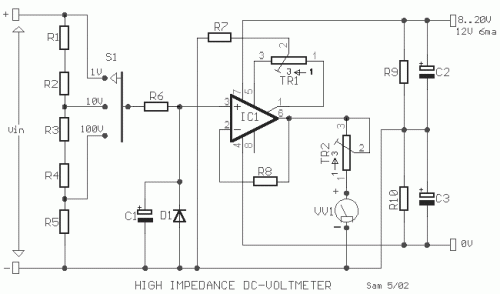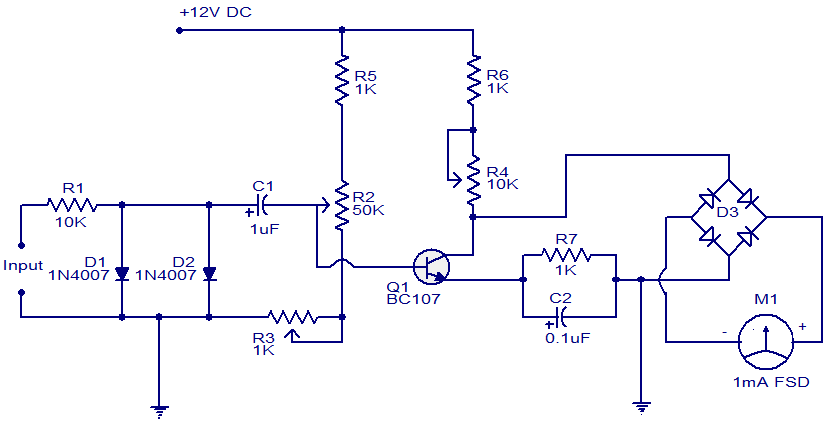
Instrumentation meter driver

Three operational amplifiers U1, U2, and U3 are configured in a basic instrumentation amplifier arrangement. Operating from ±5 V, pin 8 of each op amp is directly connected to ground, facilitating the desired AC performance for this application (high bias mode). Potentiometer P1 is utilized for offset error correction, while potentiometer P2 enables adjustment of the input common mode rejection ratio. The high input impedance allows for megohm levels without causing loading effects. The resulting circuit has a frequency response of 200 kHz at -3 dB and a slew rate of 4.5 V/µs.
The instrumentation amplifier circuit described is designed to amplify low-level differential signals while rejecting high levels of common-mode noise. The use of three operational amplifiers enhances the performance characteristics of the circuit, allowing for improved accuracy and stability. The configuration typically consists of two input op-amps (U1 and U2) that are connected to the differential inputs of the signal, while the third op-amp (U3) is used for further amplification and signal conditioning.
The power supply of ±5 V ensures that the op-amps operate within their linear range, which is critical for maintaining signal integrity. The direct connection of pin 8 to ground helps establish a reference point for the op-amps, which is essential for achieving high bias performance. This configuration is particularly beneficial in applications where precision is paramount, such as in sensor signal processing or medical instrumentation.
Potentiometers P1 and P2 play crucial roles in fine-tuning the circuit. P1 allows for the correction of any offset errors that may arise due to mismatches in the op-amps or external components, ensuring that the output accurately reflects the input signal. P2, on the other hand, adjusts the common-mode rejection ratio (CMRR), which is vital for minimizing the impact of noise that is present on both the positive and negative input lines.
The high input impedance of the circuit, which can reach megohm levels, ensures that the amplifier does not load down the source signal, preserving the integrity of the input. This characteristic is particularly advantageous when interfacing with high-impedance sensors or transducers.
The frequency response of 200 kHz at -3 dB indicates that the circuit can effectively handle signals with frequencies up to this limit before the gain begins to roll off. Additionally, the slew rate of 4.5 V/µs signifies the maximum rate at which the output can change, which is important for accurately tracking fast-changing input signals. This combination of features makes the instrumentation amplifier an excellent choice for precision applications requiring high fidelity and low noise.Three op amps Ul, U2, and U3 are connected in the basic instrumentation amplifier configuration. Operating from ± 5 V, pin 8 of each op amp is connected directly to ground and provides the ac performance desired in this application (high bias mode). PI is for offset error correction and P2 allows adjustment of the input common mode rejection ratio. The high input impedance allows megohms without loading. The resulting circuit frequency response is 200 kHz at -3 dB and has a slew rate of 4.5 V//xs.
The instrumentation amplifier circuit described is designed to amplify low-level differential signals while rejecting high levels of common-mode noise. The use of three operational amplifiers enhances the performance characteristics of the circuit, allowing for improved accuracy and stability. The configuration typically consists of two input op-amps (U1 and U2) that are connected to the differential inputs of the signal, while the third op-amp (U3) is used for further amplification and signal conditioning.
The power supply of ±5 V ensures that the op-amps operate within their linear range, which is critical for maintaining signal integrity. The direct connection of pin 8 to ground helps establish a reference point for the op-amps, which is essential for achieving high bias performance. This configuration is particularly beneficial in applications where precision is paramount, such as in sensor signal processing or medical instrumentation.
Potentiometers P1 and P2 play crucial roles in fine-tuning the circuit. P1 allows for the correction of any offset errors that may arise due to mismatches in the op-amps or external components, ensuring that the output accurately reflects the input signal. P2, on the other hand, adjusts the common-mode rejection ratio (CMRR), which is vital for minimizing the impact of noise that is present on both the positive and negative input lines.
The high input impedance of the circuit, which can reach megohm levels, ensures that the amplifier does not load down the source signal, preserving the integrity of the input. This characteristic is particularly advantageous when interfacing with high-impedance sensors or transducers.
The frequency response of 200 kHz at -3 dB indicates that the circuit can effectively handle signals with frequencies up to this limit before the gain begins to roll off. Additionally, the slew rate of 4.5 V/µs signifies the maximum rate at which the output can change, which is important for accurately tracking fast-changing input signals. This combination of features makes the instrumentation amplifier an excellent choice for precision applications requiring high fidelity and low noise.Three op amps Ul, U2, and U3 are connected in the basic instrumentation amplifier configuration. Operating from ± 5 V, pin 8 of each op amp is connected directly to ground and provides the ac performance desired in this application (high bias mode). PI is for offset error correction and P2 allows adjustment of the input common mode rejection ratio. The high input impedance allows megohms without loading. The resulting circuit frequency response is 200 kHz at -3 dB and has a slew rate of 4.5 V//xs.





